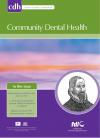Community Dental Health

- Cover Date:
- September 2007
- Print ISSN:
- 0265 539X
- Vol:
- 24
- Issue:
- 3
Oral health acculturation in Albanian-speakers in south London
Objective To explore the processes involved in oral health acculturation for Albanian-speakers in south London. Basic research design A qualitative study utilizing 10 in-depth, semi-structured interviews and two focus groups with a purposive sample of 23 Albanian-speakers. Participants were recruited through community groups and by a snowball technique. Data were analysed using the constant comparative method. Results Participants attended the dentist more regularly and brushed their teeth more frequently in the UK, particularly those from lower social class groups. However, young people consumed more sweet foods and drinks than in Kosovo. The priority of oral health was higher in the UK for most participants. Mothers of young children were more interested in prevention in the UK, mainly as a result of receiving oral health information from health visitors and agencies such as Sure Start. However, oral health priorities generally remained treatment focused. Participants mainly attributed behavioural and attitudinal changes to structural and material factors such as the absence of war, higher living standards, better access to oral health information, products and dental services, and the greater availability of highly desirable sweet foods and drinks in the UK. Conclusions Understanding changes in social context may be crucial for comprehending the processes of oral health acculturation in immigrant populations. Material and structural changes which impact on oral health behaviours may be overlooked. Improving oral health knowledge can be a crucial step in shifting oral health priorities from a treatment to a prevention focus. However, unhealthy choices may persist due to the impact of wider cultural norms.
Key words: Acculturation, Albanian, oral health, qualitative, social context
- Article Price
- £15.00
- Institution Article Price
- £
- Page Start
- 149
- Page End
- 155
- Authors
- E. Bower, J.T. Newton
Articles from this issue
- Title
- Pg. Start
- Pg. End
- The prescription and outcomes of fissure sealants applied to a group of high caries risk children by general dental practitioners working in the North West of England
- 135
- 139
- Assessment of orthodontic treatment needs in Brazilian schoolchildren according to the Dental Aesthetic Index (DAI).
- 145
- 148
- Dental caries in 5-year-old children attending multi-ethnic schools in Greater Glasgow – the impact of ethnic background and levels of deprivation
- 161
- 165
- Cross-cultural adaptation of the Oral Health Impact Profile (OHIP) for the Malaysian adult population.
- 166
- 175
- Reduction of caries in rural school-children exposed to fluoride through a Milk-Fluoridation Programme in Araucania, Chile
- 186
- 191
- Getting through Dental Fear with CBT: A young person’s guide. Helen Chapman and Nick Kirby-Turner. ISBN 1-904127-07-X. Blue Stallion Publications, Oxon. £4.95
- 192
- 192
